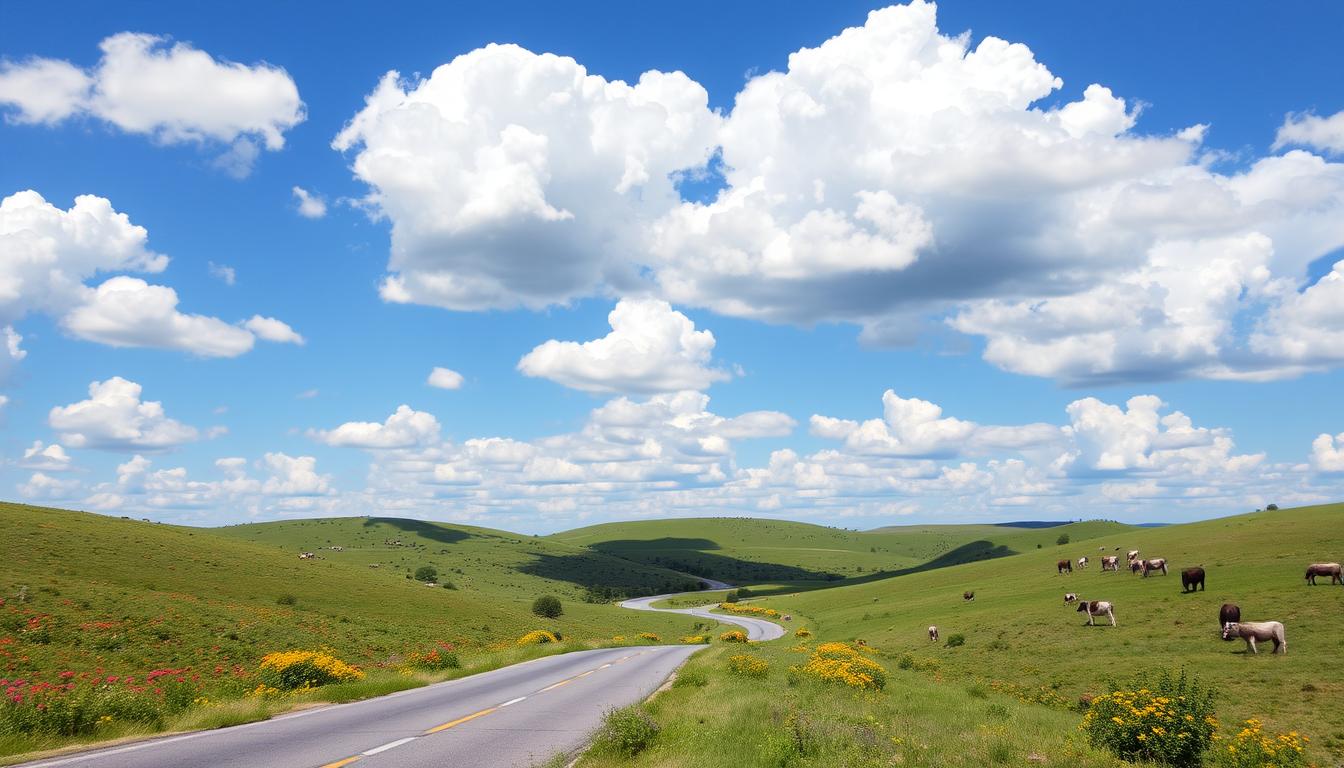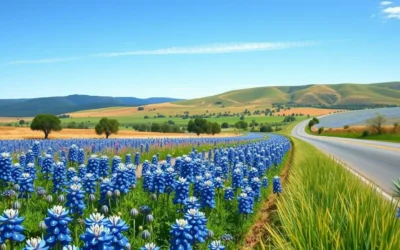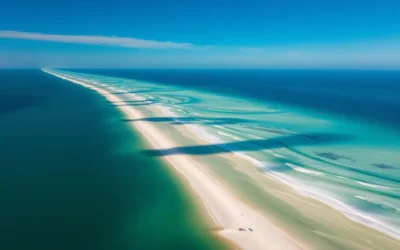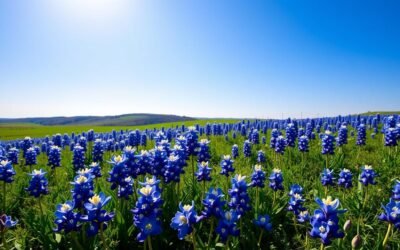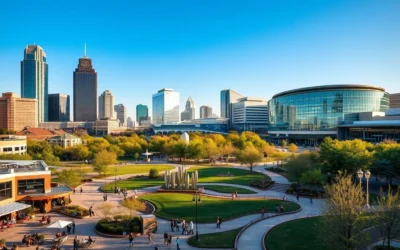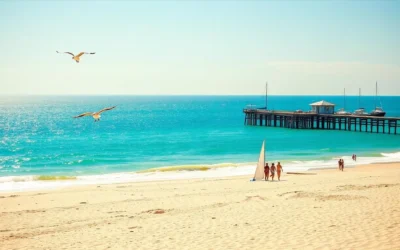✓ Accommodations ✓ Flights ✓ Rental Cars
Are you planning a trip to the captivating Texas Hill Country? Wondering when is the best time to visit? The region’s weather can be a fun challenge to figure out. With the right info, you can plan your trip to perfection.
Find out the best months to see the Hill Country’s beautiful landscapes, lively culture, and outdoor fun. It’s all about the weather.
Key Takeaways
- The Texas Hill Country offers a unique blend of continental, mountain, and marine climates.
- Spring, between late March and April, is the prime time for visiting with mild temperatures and blooming wildflowers.
- Summer brings intense heat and humidity, but the region offers ways to beat the heat and enjoy the season.
- Fall’s mild weather makes it another excellent time to explore the Hill Country’s outdoor pursuits.
- Weather conditions can vary significantly across the region, so planning ahead is crucial for a weather-savvy trip.
Understanding Texas Hill Country’s Climate Zones
Texas Hill Country has a unique climate that makes it stand out in Texas. It’s a semi-arid area between Austin and San Antonio. Here, summers are hot, and winters are mild. Temperatures can swing a lot, with summers over 90°F and winters sometimes below freezing.
Semi-Arid Climate Characteristics
The semi-arid climate of Texas Hill Country is known for its moderate rain and high evaporation. This climate has:
- Limited annual rainfall, mostly in spring and early fall
- Low humidity, especially in summer
- Frequent droughts and water scarcity
Temperature Variations Throughout the Year
Temperatures in Texas Hill Country vary a lot throughout the year. Summers are hot and dry, with highs in the 90s. Winters are mild, with lows in the 30s and 40s.
Impact of Geographical Features on Weather
The geography of Texas Hill Country greatly affects its weather. The hills, valleys, and rivers mix continental, mountain, and marine climates. This results in:
- Cooler temperatures in higher elevations
- More rain on windward slopes
- Microclimates that vary a lot
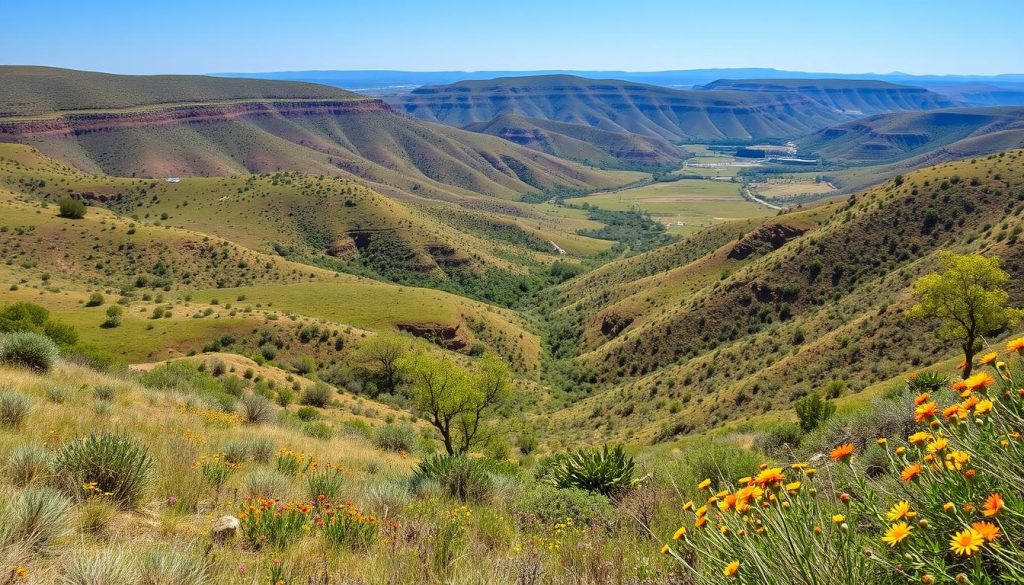
Knowing Texas Hill Country’s climate is key for travelers. By understanding the semi-arid conditions, temperature changes, and geography, visitors can plan better. This way, they can enjoy their trip to the fullest in this beautiful part of Texas.
Spring: Prime Time for Hill Country Adventures
The Texas Hill Country awakens in spring, from mid-March to mid-May. It’s the best time for those who love good weather. You’ll enjoy mild days, often in the 60s and 70s°F. The area’s wildflowers, like bluebonnets, turn the landscape into a colorful wonderland.
Spring showers bring brief but intense thunderstorms. This makes the weather exciting. It’s perfect for hiking, seeing wildflowers, and enjoying outdoor festivals. The mild weather and blooming flowers make it great for exploring the Texas Hill Country’s natural beauty.
The Texas Hill Country is home to over 5,000 wildflower species. The National Wildflower Research Center (now Lady Bird Johnson Wildflower Center) was started in 1982 by Lady Bird Johnson in Austin. Wildseed Farms in Fredericksburg, the largest wildflower farm in the U.S., covers over 200 acres. It’s a sight to see.
- Drive the Bluebonnet Highway, an 80-mile scenic route from Marble Falls to Llano, for amazing wildflower views.
- Find diverse wildflower trails in Marble Falls, like Bluebonnet and Texas Paintbrush.
- See bluebonnets and Indian paintbrushes at Baby Head Cemetery near Llano.
- Explore Llano’s 35-mile Wildflower Loop, the Wildflower Capital of Texas.
- Marvel at the Willow City Loop, a 13-mile stretch perfect for photographers.
Spring is the best time for wildflowers, but the Texas Hill Country has more to offer. You can visit wineries, caves, and historical sites like the LBJ Ranch. There are also many outdoor adventures in the charming towns.
“The Texas Hill Country comes alive in the spring, with mild temperatures and a vibrant tapestry of wildflowers that transform the landscape.”
Summer Weather Patterns and Travel Considerations
Summer in Texas Hill Country brings high heat and humidity. Temperatures often hit over 90°F in July and August. It’s important to stay safe while enjoying outdoor activities.
Managing the Heat and Humidity
Stay hydrated and wear light, light-colored clothes to beat the heat. Seek shade and cool off in air-conditioned spaces during the hottest times. Knowing the signs of heat-related illnesses is key to staying safe.
Best Summer Activities Despite High Temperatures
Water activities are a great way to cool off in Texas Hill Country. Tubing down rivers or swimming in natural springs is refreshing. Exploring parks and trails in the early morning or evening is also a good idea.
Hurricane Season Awareness
The Texas Hill Country is in the Atlantic hurricane season, from June to November. While direct hits are rare, it’s good to stay updated on storms. Be ready to change your travel plans if needed.
| Activity | Best Time to Visit | Considerations |
|---|---|---|
| River Tubing | Early Morning or Late Afternoon | Wear sun-protective clothing and stay hydrated |
| Natural Springs | Throughout the Day | Avoid the hottest hours and monitor for weather changes |
| Hiking Trails | Early Morning or Evening | Bring plenty of water and wear appropriate footwear |
Fall Season in Texas Hill Country: A Weather Guide
As summer’s heat fades, the Texas Hill Country becomes a paradise for outdoor lovers. From September to November, the weather cools down and humidity drops. This makes it the perfect time to explore this beautiful area.
The fall months see highs between 70-80°F. Evenings are cooler, offering a nice break. This weather is ideal for hiking, wine tasting, and enjoying harvest festivals.
While Texas Hill Country’s fall colors might not be as intense as in the north, some spots still show off vibrant colors. The peak time for viewing the fall foliage is usually mid-October to early November. October is the best month to see the leaves change.
The Lost Maples State Natural Area is a top spot for fall lovers. It gets busier on weekends and around Thanksgiving. The park offers a weekly foliage report with photos starting in October, helping you plan your visit.
Other great places in Texas Hill Country include Garner State Park. It has a wide range of colors from different trees.
No matter what fall activities you enjoy, the Texas Hill Country is a great place to be. It offers comfortable weather and stunning views for your outdoor adventures.
Texas Hill Country, Texas: Best Months for a Weather-Savvy Trip
The Texas Hill Country is a mix of natural beauty and culture. It has rolling hills, natural springs, and wildflowers. Spring and fall are the best times to visit because of the weather.
March to May: Wildflower Season
Spring in the Texas Hill Country is mild and beautiful. It’s the time for the famous wildflower bloom, especially bluebonnets. You can enjoy outdoor activities, scenic drives, and small towns.
Temperatures are in the 60s to 80s Fahrenheit. This makes spring perfect for seeing the area’s beauty.
October to November: Mild Weather Period
Autumn in the Texas Hill Country is cool and lovely. It’s the start of harvest season for local vineyards. The weather is mild, great for hiking, exploring, and wine tasting.
Weather-Based Activity Planning
Plan your trip to the Texas Hill Country with the weather in mind. Spring and fall are best for outdoor fun. Summer is better for indoor activities and water sports.
The best months to visit the Texas Hill Country are March to May and October to November. The weather is perfect for a great trip.
Essential Weather Considerations for Outdoor Activities
Outdoor lovers planning trips to the Texas Hill Country need to watch the weather. The area’s climate changes a lot, affecting how fun and safe activities are. Knowing the weather patterns helps you prepare and enjoy the outdoors more.
Spring and fall are the best times for outdoor fun. The weather is mild, and it’s not too humid. You can hike, bike, and see wildlife in beautiful scenery.
Summer can be very hot and humid. To stay cool, plan your activities early in the morning or late in the evening. Always carry water and sunscreen to protect yourself from the sun.
Winter in the Texas Hill Country is usually mild but can get cold at night. Dress in layers and be ready for sudden weather changes. This way, you can enjoy the outdoors even in winter.
It’s important to check the weather forecast, no matter the season. Storms can happen quickly, bringing thunderstorms, high winds, or flash floods. Being alert and flexible helps you stay safe while exploring the Texas Hill Country all year.
Monthly Rainfall Patterns and Their Impact
Texas Hill Country has different rainfall patterns all year. This affects your travel plans and outdoor fun. Knowing these changes helps you plan a smart trip.
Peak Precipitation Periods
March to May is the wettest time here. The rain makes the area green and rivers flow. But, be ready for rain and flash floods.
Drought Seasons and Water Activities
Summer is dry, leading to drought. This makes water activities like tubing harder. Check the drought status and plan your visit wisely, as wildfires are a risk too.
Storm Season Planning
Fall also sees rain, but storms can happen any time. Watch out for thunderstorms, heavy rain, and tornadoes, especially in spring and fall. Always check the weather and have a shelter plan when near rivers or low areas.
| Season | Rainfall Patterns | Impact on Outdoor Activities |
|---|---|---|
| Spring (March-May) | High precipitation levels | Lush landscapes, flowing rivers, potential for rain showers and flash flooding |
| Summer | Drought conditions | Lower water levels, increased wildfire risk, limited water-based activities |
| Fall | Secondary rainy period | Potential for sudden storm systems, need for vigilance near waterways |
Knowing Texas Hill Country’s rainfall patterns helps plan your outdoor fun. It prepares you for any weather challenges during your trip.
Weather-Related Travel Tips and Packing Guide
When planning your Texas Hill Country trip, think about the weather. It changes a lot. Here are some tips and packing ideas to help you get ready.
In spring and fall, wear layers. This way, you can adjust to the temperature changes easily. North Central Texas has highs of 71°F (22°C) and lows of 51°F (10°C). So, clothes that can be layered are key.
In summer, choose light, breathable clothes. This keeps you cool in the heat. South Central Texas gets very hot, with highs of 78°F (25°C) and lows of 54°F (12°C). Don’t forget sun protection and bug spray.
For winter, bring warm clothes for the chilly nights. East Texas has highs of 65°F (19°C) and lows of 45°F (7°C). A good jacket or coat is a must.
Every season, you’ll need some basic items:
- Comfortable walking shoes
- Reusable water bottle
- Rain gear, like a lightweight jacket or umbrella
Check the weather forecast before you go. This helps you pack better and be ready for any weather changes in the Texas Hill Country.
By packing for the weather, you can enjoy the Texas Hill Country, rain or shine.
Local Events and Weather-Dependent Festivals
Texas Hill Country is alive with local events and festivals all year. In spring, it’s all about the wildflowers with outdoor fun. Summer brings rodeos, Fourth of July celebrations, and live music under the stars.
Fall is harvest time, with festivals, wine tastings, and art shows. Winter lights up with holiday displays and New Year’s parties.
Don’t miss the Kerrville Folk Festival, Fredericksburg’s Oktoberfest, and food and wine festivals. Check the weather and event schedules to enjoy your trip fully. This way, you’ll make memories that last a lifetime in Texas Hill Country.
Spring’s wildflowers, summer’s activities, fall’s harvest, and winter’s lights all have their charm. The Texas Hill Country has something for everyone. Dive into its spirit and enjoy the seasonal highlights for a memorable visit.
The above is subject to change.
Check back often to TRAVEL.COM for the latest travel tips and deals.
